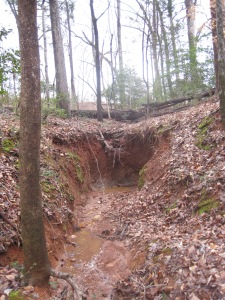Abstract: Timescales of drainage network evolution are driven by coupled changes in landscape properties and hydrologic response
I will be at the CUAHSI 3rd Biennial Colloquium on Hydrologic Science and Engineering on July 16-18, 2012 in Boulder, Colorado. I’ve been asked to speak in a session on the co-evolution of geomorphology and hydrology. This is a cool opportunity for me, as I’ve been thinking about co-evolution in both volcanic landscapes and Piedmont gullies for the past couple of years. I’m going to attempt to stitch those two very different landscapes and timescales together in one conceptual framework in the talk, and I guess we’ll see how it goes.
Timescales of drainage network evolution are driven by coupled changes in landscape properties and hydrologic response
Anne J. Jefferson
In diverse landscapes, channel initiation locations move up or downslope over time in response to changes in land surface properties (vegetation, soils, and topography) which control the partitioning of water between subsurface, overland, and channelized flowpaths. In turn, channelized flow exerts greater erosive power than overland or subsurface flows, and can much more efficiently denude and dissect the landscape, leading to altered flowpaths and land surface properties. These feedbacks can be considered a fundamental aspect of catchment coevolution, with the headward extent of the stream network and landscape dissection as prime indicators of the evolutionary status of a landscape.
Drainage network evolution in response to landscape change may occur over multiple timescales, depending on the rapidity of change in the hydrogeomorphic drivers. Climate and lithology may also modify the rates at which drainage networks respond to change in land surface properties. On basaltic landscapes, such as the Oregon Cascades, timescales of a million years or more can be necessary to evolve from an undissected landscape with slow, deep groundwater drainage to a fully-dissected landscape dominated by shallow subsurface stormflow and rapid hydrograph response in streams. This evolution seems to be driven by a slow change in land surface properties and permeability as a result of weathering, soil development, and mantling by low permeability materials, but may also reflect the high erosion resistance of crystalline bedrock. Conversely, rapid or near-instantaneous changes in land surface properties , such as accompanied the beginning of intensive agriculture in the southeastern Piedmont, can propagate into rapid (1-10 year) changes in channel network extent on clay-rich soils. Where agriculture has been abandoned in this region and forests have regrown, downslope retreat and infilling of extensive gully networks is occurring on decadal timescales.
